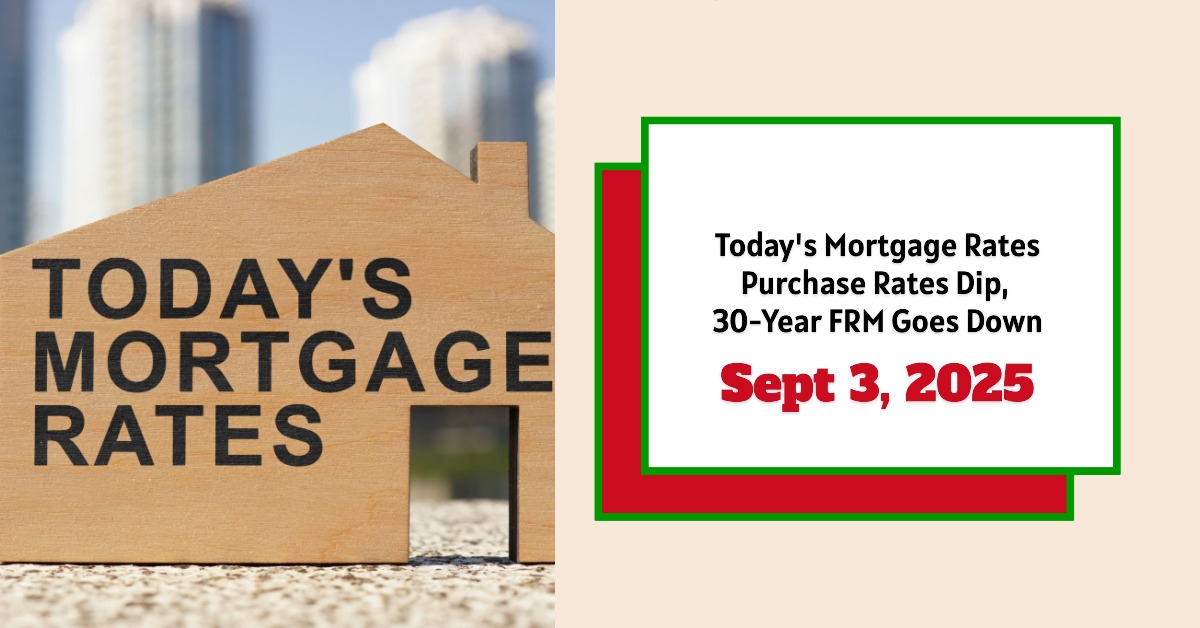As of September 3, 2025, mortgage rates today have slightly dropped for homebuyers with the national average 30-year fixed mortgage rate decreasing to 6.58%—down 1 basis point from last week’s 6.59%. Meanwhile, refinance rates have inched higher, with the average 30-year fixed refinance rate rising to 6.86%, up 2 basis points from the previous week. This small dip in purchase mortgage rates, coupled with ongoing economic signals, is creating a cautiously hopeful market environment for buyers and refinancers alike.
Mortgage Rates Today- September 3, 2025: Purchase Rates Dip, 30-Year FRM Goes Down
Key Takeaways
- 30-year fixed mortgage rate for purchases dropped marginally to 6.58%.
- 15-year fixed purchase rates hold steady at 5.68%.
- 5-year ARM purchase rates significantly decreased to 6.79%.
- Refinance rates, especially 30-year fixed, have slightly increased to 6.86%.
- Federal Reserve expected to cut rates in mid-September, potentially lowering mortgage costs soon.
- Despite recent drops, mortgage rates are expected to remain above 6% through 2025.
- Economic slowdown and easing inflation likely to influence mortgage rate trends.
Today’s Mortgage and Refinance Rates Explained
Mortgage rates represent the interest charged by lenders on home loans. They fluctuate daily depending on market forces, economic data, and Federal Reserve policies which influence bond yields that underpin mortgage costs.
On September 3, the national average 30-year fixed mortgage rate for home purchases slid slightly from 6.59% to 6.58%—a minor movement, but notable as it marks the lowest rates seen in roughly ten months. The drop signals cautious optimism as housing buyers could see marginally cheaper financing.
By contrast, 30-year fixed refinance rates edged upward from 6.84% to 6.86%. This divergence between purchase and refinance rates suggests that while borrowing to buy homes is becoming a bit more attractive, refinancing existing loans remains costlier.
Detailed mortgage rate table for conforming loans highlights today’s exact figures:
| Loan Type | Rate (%) | Weekly Change (%) | APR (%) | Weekly APR Change (%) |
|---|---|---|---|---|
| 30-Year Fixed | 6.58 | down 0.01 | 6.95 | down 0.08 |
| 20-Year Fixed | 6.28 | down 0.15 | 6.56 | down 0.29 |
| 15-Year Fixed | 5.68 | up 0.02 | 5.92 | down 0.03 |
| 10-Year Fixed | 5.79 | no change | 6.09 | no change |
| 7-Year ARM | 7.08 | up 0.03 | 7.60 | down 0.10 |
| 5-Year ARM | 6.79 | down 0.08 | 7.44 | down 0.15 |
Source: Zillow (September 3, 2025)
Government loans showed mixed movement:
| Loan Type | Rate (%) | Weekly Change (%) | APR (%) | Weekly APR Change (%) |
|---|---|---|---|---|
| 30-Year FHA Fixed | 7.25 | up 1.23 | 8.30 | up 1.28 |
| 30-Year VA Fixed | 6.12 | up 0.06 | 6.34 | up 0.07 |
| 15-Year FHA Fixed | 5.51 | up 0.01 | 6.48 | up 0.01 |
| 15-Year VA Fixed | 5.77 | up 0.08 | 6.13 | up 0.10 |
Refinance rates for September 3, 2025:
| Loan Type | Rate (%) | Weekly Change (%) | APR (%) | Weekly APR Change (%) |
|---|---|---|---|---|
| 30-Year Fixed Refi | 6.86 | up 0.03 | — | — |
| 15-Year Fixed Refi | 5.59 | up 0.01 | — | — |
| 5-Year ARM Refi | 7.40 | up 0.13 | — | — |
Source: Zillow (September 3, 2025)
Why Are Mortgage Rates Changing Now? The Economic and Fed Context
Mortgage rates tend to move with long-term Treasury yields—especially the 10-year Treasury note—which reflect investor expectations about future inflation, economic growth, and Federal Reserve interest rate policies. Currently, the 10-year Treasury yield sits around 4.23%, and the 30-year Treasury yield about 4.89%, both key anchors for mortgage lending.
Throughout much of 2025, rates hovered between 6.6% and 6.8%. Recent indicators including slowing job growth in early August and cooler inflation have swayed market expectations toward a Federal Reserve rate cut at their mid-September meeting. The probability is extremely high—about 91%—that the Fed will reduce the federal funds rate by 0.25% (a quarter point). This easing would typically lower borrowing costs, potentially nudging mortgage rates further downward.
The Fed’s rate actions between 2021 and 2023 were aggressive in raising borrowing costs to combat inflation, pushing mortgage rates to two-decade highs. After steady hikes culminating in a federal funds rate above 5%, the Fed pivoted in late 2024 to cut rates, starting an easing phase.
In 2025, after five steady meetings with no rate changes, pressure is building for cuts due to:
- Inflation cooling (Core PCE near 2.7%)
- Slowing GDP growth
- Rising unemployment (now 4.2%)
- Moderating job market
Markets have priced in these factors, with a positive yield curve meaning longer-term yields exceed short-term yields, signaling expectations of future rate decreases.
Fed Chair Jerome Powell’s recent speech hinted at data dependency but leaned toward easing, confirming the market expectation for a September cut.
Mortgage Rate Forecasts and Industry Expectations
Industry projections paint a detailed picture of mortgage rates near term:
- National Association of REALTORS® expects mortgage rates to average around 6.4% in the second half of 2025, falling further to about 6.1% in 2026.
- Fannie Mae’s August 2025 forecast sees year-end mortgage rates at 6.5%, dropping to 6.1% in 2026, with modest upward revisions over prior estimates.
- Realtor.com predicts rate easing through 2025, with average rates slowly declining to about 6.4% by year-end.
- Mortgage Bankers Association expects some volatility but forecasts a 30-year mortgage rate near 6.7% by end 2025, easing to 6.5% in 2026.
These forecasts account for ongoing economic uncertainties but reflect broad consensus that rates will likely stay above 6% for the foreseeable future.
Comparing Mortgage Rate Trends for Homebuyers and Refinancers
A key point is that purchase mortgage rates and refinance rates are not always moving together. Currently, purchase rates trend slightly downward while refinance rates show marginal increases.
| Type | Current Rate (%) | Previous Rate (%) | Weekly Change (%) |
|---|---|---|---|
| 30-year purchase | 6.58 | 6.59 | -0.01 |
| 30-year refinance | 6.86 | 6.84 | +0.02 |
This separation occurs because lenders price refinance loans based on different risk profiles and market factors. For example, lenders have tightened some refinance guidelines due to previous refinancing booms and concerns about profitability.
For potential homeowners, the slight dip in purchase rates might encourage some to lock in rates now, especially given uncertainty. Conversely, refinancers paying very high rates (above 7%) might hold off to see if the expected Fed cuts in September trigger a more significant drop.
Example Calculation: Impact of Today's Mortgage Rates
Let’s illustrate how a small rate change impacts a typical home loan payment.
Assuming a borrower finances $300,000 on a 30-year fixed mortgage:
| Rate | Monthly Payment* | Total Interest Over 30 Years |
|---|---|---|
| 6.59% | $1,913 | $389,832 |
| 6.58% | $1,911 | $388,696 |
*Principal + interest only
A mere 0.01% rate drop saves the borrower about $2 per month or $1,136 in interest over the life of the loan. While subtle, this highlights how even small rate changes can add up over 30 years.
Related Topics:
Mortgage Rates Trends as of September 2, 2025
Mortgage Rates Predictions Next 90 Days: August to October 2025
How The Federal Reserve’s Policies Influence Mortgage Rates in 2025
The Fed’s monetary policy remains the single biggest driver behind mortgage rates. Its strategies over the past few years have included:
- Large-scale bond purchases during the pandemic to keep borrowing cheap.
- Rapid rate hikes starting in 2022 to tackle inflation, lifting mortgage rates.
- Easing stance in late 2024 with rate cuts to stimulate a slowing economy.
- Holding rates steady in early 2025 amidst mixed signals.
Now, the market strongly anticipates further cuts in the coming months, which would directly lower the federal funds rate, indirectly pushing mortgage rates down.
Still, inflation remains sticky, and economic surprises can derail predictions. Thus, experts urge caution in fully banking on a swift plunge below 6% until confirmed by the Fed’s actions.
Additional Insights From Industry Reports
- The National Association of REALTORS® emphasizes mortgage rates as a “magic bullet” for housing affordability and market demand.
- Fannie Mae forecasts slightly fewer mortgage originations than before but still expects growth due to better affordability from easing rates.
- The Mortgage Bankers Association notes ongoing rate volatility, which means some refinance windows may temporarily close despite overall favorable trends.
The data from Zillow and expert analyses confirms that mortgage rates today are at a minor inflection point moving toward possible easing, yet still elevated compared to historical norms. This means buyers and refinancers alike face a landscape where timing and personal circumstances remain crucial.
For those watching the September Fed meeting closely, market signals point toward a rate cut that, if realized, could set the stage for more accessible borrowing costs later this year. However, rates staying above 6% for several quarters means that getting into the market or refinancing requires careful financial planning.
Capitalize Amid Rising Mortgage Rates
With mortgage rates expected to remain high in 2025, it’s more important than ever to focus on strategic real estate investments that offer stability and passive income.
Norada delivers turnkey rental properties in resilient markets—helping you build steady cash flow and protect your wealth from borrowing cost volatility.
HOT NEW LISTINGS JUST ADDED!
Speak with a seasoned Norada investment counselor today (No Obligation):
(800) 611‑3060
Also Read:
- Will Mortgage Rates Go Down in 2025: Morgan Stanley's Forecast
- Mortgage Rate Predictions 2025 from 4 Leading Housing Experts
- Mortgage Rate Predictions for the Next 3 Years: 2026, 2027, 2028
- 30-Year Fixed Mortgage Rate Forecast for the Next 5 Years
- 15-Year Fixed Mortgage Rate Predictions for Next 5 Years: 2025-2029
- Will Mortgage Rates Ever Be 3% Again in the Future?
- Mortgage Rates Predictions for Next 2 Years
- Mortgage Rate Predictions for Next 5 Years
- Mortgage Rate Predictions: Why 2% and 3% Rates are Out of Reach
- How Lower Mortgage Rates Can Save You Thousands?
- How to Get a Low Mortgage Interest Rate?
- Will Mortgage Rates Ever Be 4% Again?



